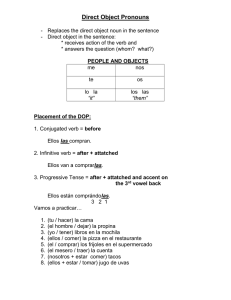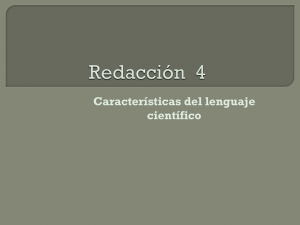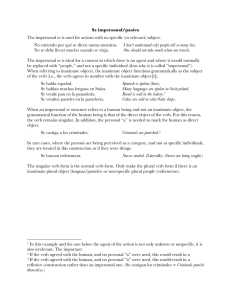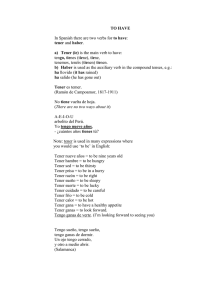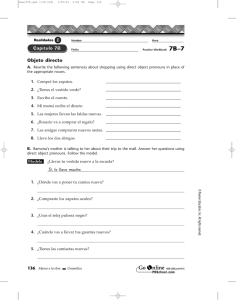Se impersonal, se pasivo
Anuncio
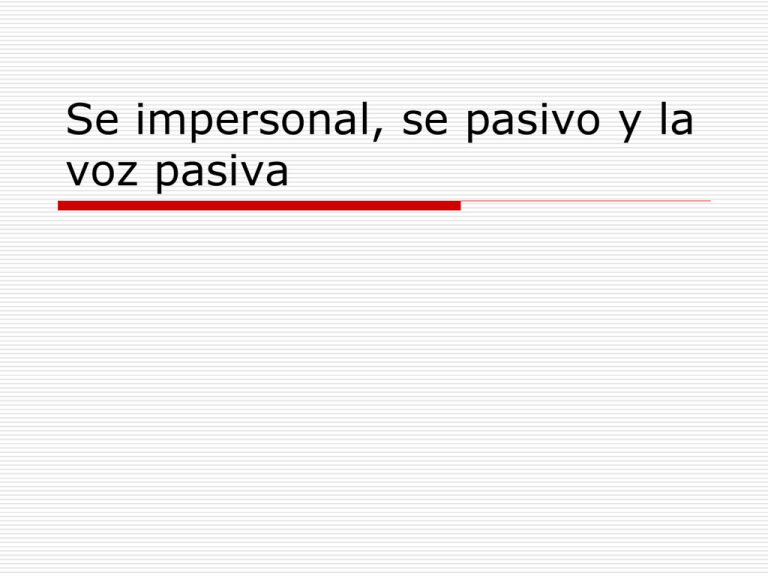
Se impersonal, se pasivo y la voz pasiva Passive “se” Can only be used with transitive verbs. Can only be used with verbs in the 3rd person. Can be singular or plural 3rd person forms. Usually used with non-human nouns and pronouns. Passive “se” examples Se sirve el vino en una copa de vidrio. The wine is served in a glass. Se sirven los vinos en una copa de vidrio. The wines are served in a glass. Se alquila una casa. House for rent. Impersonal “se” Is used with 3rd person verbs. Is equivalent to “one” or “people” Is used most commonly with transitive verbs. Impersonal “se” examples No se entra. Do not enter. Se dice que va a llover… They say it’s going to rain… Se cruza si el semáforo está en verde… You can cross on green… Contrasting and Comparing It is hard to distinguish between the impersonal and passive “se”. The difference lies in whether or not the context refers to a direct object (implied or apparent): If the context refers to a direct object then it is the passive “se”. If it does not refer to a direct object then it is the impersonal “se”. Example En España se come mucho ajo. In Spain a lot of garlic is eaten. PASSIVE “SE” because “ajo” is the direct object of “come”. En España se come mucho. In Spain people eat a lot. IMPERSONAL “SE” because “come” does not refer to a direct object, it´s just a general observation about eating habits. Unintentional Occurrences To express an accidental occurrence (or one you don’t want to take responsibility for) you can use certain verbs with a particular construction. Unintentional Occurrences se se se se se se me + preterit verb te + preterit verb le + preterit verb nos + preterit verb os + preterit verb les + preterit verb Examples Se me olvidó hacer la tarea. I forgot to do my homework. My homework didn’t get done. OR Se te rompió el vaso. You broke the glass. OR The glass broke, and you just happened to be there when it happened. Tips The verb agrees with the noun following it. The person who does the action “accidentally” is represented by the indirect object pronoun. Common verbs used with this construction: caer, olvidar, perder, quemar, romper La voz pasiva Otras maneras de expresiones no activas (pasivas) son las siguiente: SER + participio pasado + por El subjeto no hace la acción, sino el objeto. Funciona también: Pretérito perfecto de SER + participio pasado ESTAR + participio pasado El resultado de una acción anterior. La voz pasiva SER + participio pasado + *por Frase “activa” La maestra enseñó la clase. Frase “pasiva” La clase fue enseñada por la maestra. La clase ha sido enseñada por la maestra. La voz pasiva ESTAR + participio pasado + por Frase pasiva: La puerta está abierta. La frase es pasiva porque un objeto inanimado y no un individuo, es el subjeto de la frase. Es pasiva porque se supone que la puerta no “se abrió”, sino que una persona la abrió, Y ahora está en el estado resultado.
